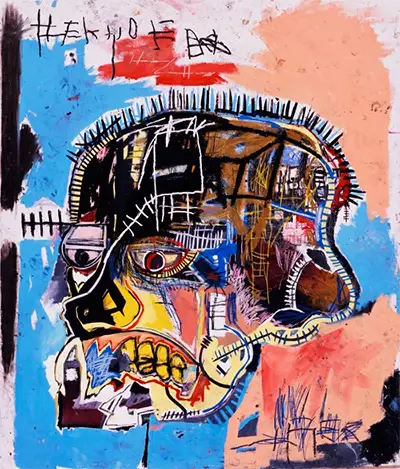This piece, which remained untitled, but many still refer to simply as "Skull", is likely inspired by this key moment in his history. It was created in 1981 when Basquiat was merely twenty and is an example of Basquiat's early canvas-based work. Although this painting is often referred to as Skull, it is an untitled piece which was presented at his debut solo gallery exhibition in New York City. While most of his artwork is completed in a few days, Basquiat laboured over this in painting for months. This piece is likely to be influenced by the pressure of becoming commercially successful. Another theory of its conception comes from the Voodoo symbol that a skull represent, which was practiced by his Haitian father. This piece was created using acrylic and mixed media, including crayon, on canvas. It features a patchwork skull suspended on top of a map-like background. This contemporary graffitist's take on western self portraits seems to portrays Basquiat's life as a curbside peddler and homeless floater.
In Untitled, 1981 (Skull), the dichotomies of inner versus outer experience are emphasised. Akin to an actual skull, the teeth and jaw are bare and skinless. However, unlike a skull, the eyes, ears and hairs along with room-like spaces inside the skull suggest that of an external perception of the head. It is as if we can see the inside and the outside of the skull at the same time. This allusion to the skull being alive and dead at once is in line with Basquiat's recurring theme of suggestive dichotomies shown in many of his works. Looking at the visage, even though there are eyes, nose and teeth, the painting gives the illusion of an incomplete face. The head is filled with graffiti and gives the impression that it contains forms and figures but, closer inspection reveals abstract lines and shapes. Chunks seem missing from the face almost as though parts of the face is missing skin. The black skin draws the eye to the brighter yellow of the jaw bone and the orange teeth. Despite the use of these vibrant colours the piece is rather morbid and dismal.
The figure itself gives a feeling of tenseness exhibited by the clenching of the jaw and the downward turn of the mouth. The head is subdued, the face is sunken in and even the listless eyes seem to look downwards almost in displeasure or weariness. Basquiat may have been alluding to the appropriation of African masks in art and uses the mask to explore the idea of identity. At first glance, this piece seems easy to understand, the colours and the skull are not complex. However, like many of his other works, the meaning is obscured. Is it simply stating the incoherence of the artist's identity or does it show his unique perception of society? What does the black skin, that fades to tainted bones, say about race? The artist provides no clear answers when audiences come to question what this piece truly means.

 in Detail Jean-Michel Basquiat.jpg)

